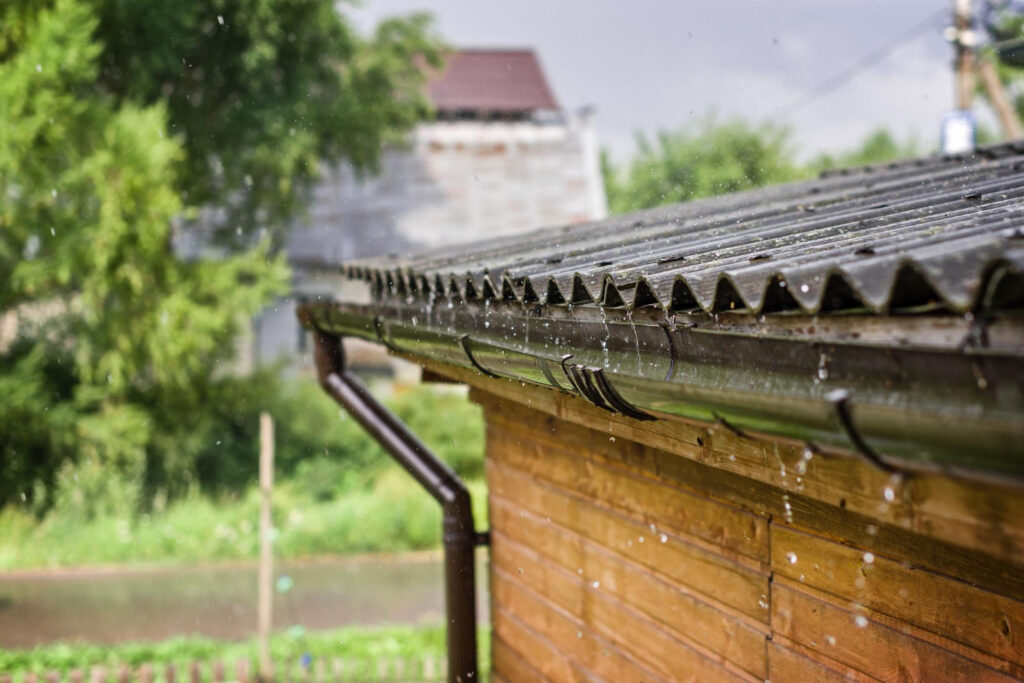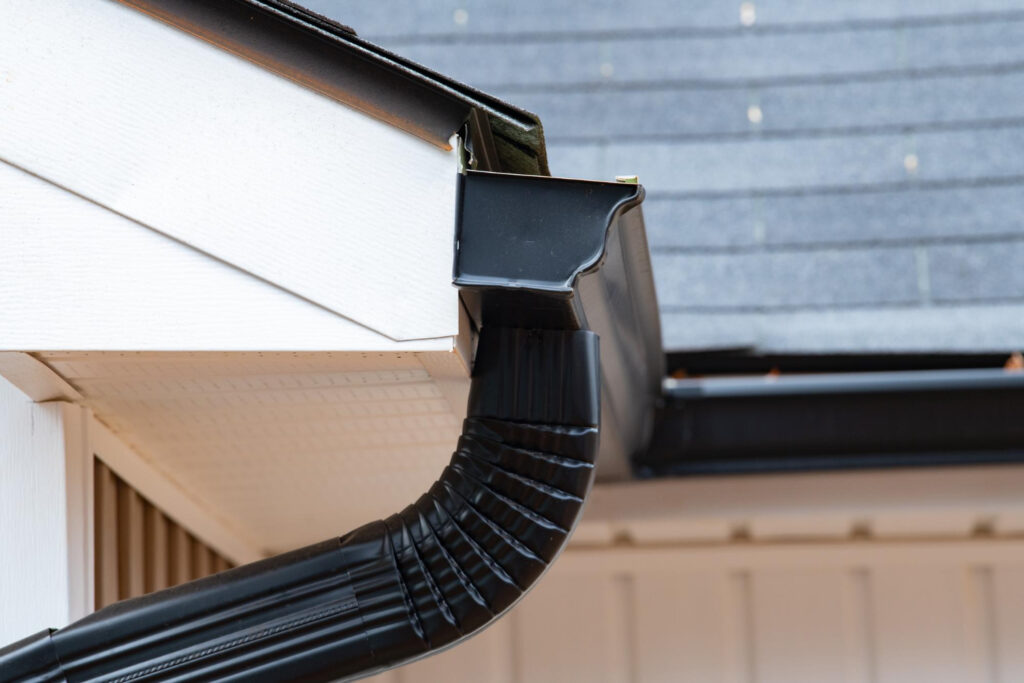DIY Gutter Alternatives
As a homeowner, I've come to realize the importance of having well-functioning gutters for safeguarding my home from potential water damage. However, the cost of installing and maintaining traditional gutter systems can be quite daunting.
Thankfully, I've discovered a range of DIY gutter alternatives that offer effective protection without draining my wallet. In this guide, I'll share my journey and insights into these budget-friendly options, empowering you to make informed decisions to protect your own home.
Why Consider DIY Gutter Alternatives?
When considering the possibility of implementing do-it-yourself (DIY) gutter alternatives for your home, it's essential to delve deeper into the reasons behind this choice in comparison to traditional gutter systems. There are several compelling advantages to opting for DIY gutter alternatives:
- Cost Savings: Traditional gutter systems often come with a substantial price tag for both purchase and installation. In contrast, DIY alternatives are typically much more budget-friendly, allowing homeowners to save a significant amount of money.
- Simplified Maintenance: Many DIY gutter alternatives are thoughtfully designed with straightforward maintenance in mind. This design approach minimizes the need for expensive professional services, making it easier for homeowners to keep their gutter systems in top condition.
- Customization: One of the standout benefits of DIY options is the freedom they offer for customization. Homeowners can tailor their gutter systems to align perfectly with their home's unique requirements and aesthetic preferences, ensuring a seamless integration with the overall design.
- Eco-Friendly Options: Some DIY alternatives prioritize environmental sustainability by incorporating eco-friendly materials and installation methods. This green approach not only benefits the planet but also contributes to a more eco-conscious living environment for homeowners.
DIY gutter alternatives
Now that you understand the benefits, let's delve into some popular DIY gutter alternatives:
Rain Chains
Rain chains are a delightful combination of form and function, offering an aesthetically pleasing alternative to conventional downspouts. These artistic fixtures typically consist of an array of decorative cups or links designed to gracefully channel rainwater from your roof to the ground. Beyond their visual appeal, rain chains also create a serene atmosphere as water trickles down, providing a soothing and tranquil experience.
Installation Process:
- Remove Existing Downspouts: To make way for your rain chain, start by removing your traditional downspouts. This step ensures a seamless transition to the new rainwater management system.
- Choose Your Rain Chain: Explore a diverse range of rain chain designs to find one that harmonizes with your home's architectural style and your personal taste. Whether you prefer simple and modern or ornate and traditional, there's a rain chain design for everyone.
- Install the Rain Chain: Attach the selected rain chain to your gutter outlet, replacing the removed downspout. It's crucial to ensure that the rain chain extends to the ground, allowing for efficient water drainage. If needed, consider adding an extension to achieve the desired length.
- Place a Catch Basin: At the base of the rain chain, position a decorative catch basin or rain barrel. This serves a dual purpose – it collects rainwater for later use in your garden, reducing water wastage, and adds another decorative element to your rain chain system.
- Maintenance: To maintain the optimal performance and appearance of your rain chain, periodically remove debris such as leaves, twigs, and dirt that may accumulate. A clean rain chain ensures unimpeded water flow, preventing any potential blockages.
Benefits of Rain Chains:
- Aesthetic Appeal: Rain chains elevate your home's curb appeal, adding a touch of elegance and charm. They serve as eye-catching accents that enhance the overall look of your property.
- Soothing Water Sound: The gentle sound of rainwater flowing through the rain chain creates a calming atmosphere. It's akin to a natural symphony that can be enjoyed from your outdoor space.
- Minimal Maintenance: Unlike traditional downspouts, rain chains require minimal upkeep. Routine cleaning is typically the extent of maintenance needed to keep them functioning optimally.
- Customizable Designs: With a wide selection of designs, materials, and finishes available, rain chains offer ample opportunities for customization. You can choose a rain chain that not only complements your home but also expresses your unique style.

Gutter Screens and Guards
Gutter screens and guards play a crucial role in maintaining the optimal functionality of your gutter system. Designed to prevent debris accumulation while allowing rainwater to flow freely, these protective devices come in various forms, including mesh screens, foam inserts, and brush guards. Their installation is a DIY-friendly endeavor that can save you the inconvenience of frequent gutter cleaning.
Installation Guide:
- Clean Gutters: Begin the installation process with clean gutters. This ensures that no debris becomes trapped beneath the screens or guards once they are in place.
- Measure and Cut: Measure the length of your gutters accurately and cut the screen or guard material to fit perfectly. A precise fit is essential for effective protection.
- Secure in Place: Attach the screens or guards to your gutter system using appropriate fasteners such as clips or screws. Ensuring a secure attachment is vital to prevent them from dislodging during heavy rains or strong winds.
- Seal Joints: To maintain a watertight seal, take the time to seal any joints or seams in the gutter system. This prevents water from leaking or bypassing the protective screens.
- Regular Inspection: Periodically inspect the screens or guards to ensure they remain free of debris and are functioning as intended. Regular cleaning and maintenance will help them continue to protect your gutters effectively.
Benefits of Gutter Screens and Guards:
- Prevents Debris Buildup: The primary function of gutter screens and guards is to keep leaves, twigs, and other debris out of your gutters. By doing so, they prevent clogs that can lead to water overflow and damage to your home's foundation and landscaping.
- Low Maintenance: Once installed, gutter screens and guards require minimal maintenance compared to traditional gutters. They significantly reduce the frequency of gutter cleaning, saving you time and effort.
- Extends Gutter Lifespan: By minimizing the accumulation of debris and reducing the stress on your gutter system, screens and guards can extend the lifespan of your gutters. This investment can save you money on gutter repairs or replacements in the long run.
- Reduces the Risk of Clogs and Water Damage: Effective gutter protection reduces the risk of clogs, which can lead to water damage to your home's interior and exterior. By allowing water to flow freely while keeping debris out, screens and guards help safeguard your property from costly water-related issues.
Rain Barrels
Rain barrels are a sustainable and environmentally friendly DIY solution that allows homeowners to collect and store rainwater for a variety of practical uses. By harnessing the power of your gutters to redirect rainwater into a barrel, you can not only reduce your water bills but also contribute to minimizing runoff, which can have adverse effects on the environment.
Installation Guide:
- Select a Location: Begin by carefully choosing the location for your rain barrel. Opt for a spot that is conveniently close to a downspout and ensure that the ground is level. This choice will optimize the collection process.
- Install Diverter Kit: Invest in and install a diverter kit that connects seamlessly to your downspout. This kit will efficiently channel rainwater into the rain barrel while ensuring any excess water continues to flow through the downspout when the barrel is full.
- Raise the Barrel: Elevate the rain barrel using cinder blocks or a sturdy platform. This elevation is crucial for generating adequate water pressure when you need to use hoses or watering cans to distribute collected rainwater around your property.
- Use Overflow Hose: Attach an overflow hose to the rain barrel's designated overflow outlet. This hose serves to divert excess water away from your home's foundation, preventing potential water damage and soil erosion.
- Regular Maintenance: To keep your rain barrel functioning optimally, perform regular maintenance. Periodically clean the interior of the barrel and ensure that it remains covered. Covering the barrel prevents debris from entering and minimizes the risk of mosquito breeding.
Benefits of Rain Barrels:
- Water Conservation: Rain barrels are instrumental in conserving water resources by allowing you to utilize rainwater for various purposes, reducing your reliance on municipal water supplies. This practice not only saves money but also helps conserve precious freshwater resources.
- Reduced Water Bills: By using harvested rainwater for tasks like watering your garden or lawn, you can significantly reduce your water bills. Rain barrels provide a cost-effective alternative to tap water for outdoor use.
- Eco-Friendly: Embracing rainwater harvesting is an environmentally responsible choice. It reduces the strain on local water sources and decreases the amount of stormwater runoff that can carry pollutants into nearby rivers and streams.
- Suitable for Gardening and Outdoor Use: Rainwater is naturally soft and free of harsh chemicals found in treated water. This makes it an ideal choice for watering plants, gardens, and lawns. The use of rainwater can also enhance the health and vitality of your outdoor green spaces.

PVC Pipe Gutter System
A PVC pipe gutter system offers an economical and highly customizable alternative to conventional gutter systems. This DIY option is well-suited for individuals with basic plumbing skills, enabling them to create an effective rainwater management system tailored to their specific needs.
Installation Guide:
- Gather Materials: Start by procuring the necessary materials, which typically include PVC pipes, elbows, brackets, and PVC cement. These components will form the foundation of your PVC pipe gutter system.
- Plan the Layout: Before diving into assembly, take the time to measure and plan the layout of your gutter system. Ensure that you establish the appropriate slope to facilitate efficient water flow. Adequate planning is crucial for the system's effectiveness.
- Cut and Assemble: Cut the PVC pipes to your desired lengths, considering the layout you've planned. Assemble the pipes using elbows and brackets to create the gutter structure. PVC cement can be used to secure the joints, ensuring they remain watertight.
- Attach to Fascia: Secure the PVC gutter system to the fascia board of your home using brackets or straps. Proper attachment ensures the stability and longevity of the system, even during heavy rainfall.
- Create Downspouts: Install downspouts at strategic locations along the gutter system to direct collected rainwater away from your home's foundation. Downspouts prevent water from pooling near the structure, which can lead to foundation issues.
- Test for Leaks: After installation, run water through the system to check for leaks or any areas that may need adjustments. Address any issues promptly to maintain the system's integrity.
Benefits of PVC Pipe Gutter Systems:
- Customizable to Fit Your Home: PVC pipe gutter systems can be tailored to the specific dimensions and layout of your home. This level of customization ensures that the gutter system effectively manages rainwater runoff from your roof.
- Cost-Effective: PVC pipes and fittings are affordable materials, making a PVC pipe gutter system a budget-friendly option for homeowners looking to enhance their rainwater management capabilities.
- DIY-Friendly for Basic Plumbing Skills: While professional installation is always an option, PVC pipe gutter systems are well-suited for individuals with basic plumbing skills. With careful planning and assembly, homeowners can tackle this project themselves, further reducing costs.
- Durable and Resistant to Rust and Corrosion: PVC pipes are known for their durability and resistance to rust and corrosion. This means your PVC pipe gutter system will have a long lifespan, requiring minimal maintenance over the years.
Rain Diverter Systems
Rain diverters offer a straightforward yet effective solution for redirecting rainwater away from vulnerable areas of your home, such as entrances and walkways. These systems are designed to be easily installed and can play a vital role in preventing water-related damage.
Installation Guide:
- Select the Location: Begin by identifying the areas around your home where water runoff poses a problem. These might include locations near doorways, walkways, or areas with frequent foot traffic.
- Install Diverters: Secure the rain diverters to your roof in the identified trouble spots using screws and appropriate sealant. Proper attachment is essential to ensure the diverters remain in place during heavy rainfall.
- Direct Water Flow: Position the diverters strategically so that they effectively guide rainwater away from the problem areas. Redirect the flow towards a safe drainage area, such as a garden bed, storm drain, or gravel pit.
- Regular Maintenance: Periodically inspect the rain diverters to ensure they are free of debris and damage. Regular cleaning and maintenance will help maintain their effectiveness in protecting your home from water damage.
Benefits of Rain Diverters:
- Protects Vulnerable Areas from Water Damage: Rain diverters act as a barrier between your home and potential water damage. By redirecting water away from entrances and walkways, they help safeguard against costly structural issues, such as foundation damage or water infiltration.
- Inexpensive and Easy to Install: Rain diverters are a cost-effective solution, both in terms of materials and installation. They are well-suited for homeowners looking for a simple and affordable way to address water runoff concerns.
- Reduces the Risk of Slips and Falls: By preventing water from accumulating in walkways and entrances, rain diverters reduce the risk of slips and falls. This is particularly important for ensuring the safety of your family and visitors during wet weather conditions.
FAQs
How do you divert water without gutters?
Without gutters, you can still divert water away from your home using various methods. One option is to create a graded slope away from the foundation, ensuring that rainwater naturally flows away from the house.
Installing downspout extensions, splash blocks, or French drains can also help redirect water away from the foundation and prevent erosion. Additionally, you can consider installing rain chains or rain barrels to capture and manage rainwater in a controlled manner.
What is the alternative to gutters?
An alternative to traditional gutters is a system known as a “rain diverter” or “rain dispersal system.” These systems consist of a series of angled panels or troughs installed on the roof's edge, allowing rainwater to disperse evenly and prevent it from falling in concentrated streams.
Rain dispersal systems are a visually less obtrusive option compared to traditional gutters and can help protect your home's foundation and landscaping from water damage.
What is the cheapest gutter system?
The cost of a gutter system can vary depending on factors like materials, installation, and the size of your home. Vinyl gutters are generally considered one of the most affordable options. They are lightweight, easy to install, and low in cost.
However, their durability may not match that of more expensive materials like aluminum or steel. DIY installation can also reduce costs, but it's essential to ensure proper installation to prevent future issues.
Is it OK to have a house without gutters?
While it is possible to have a house without gutters, it may not be the most advisable choice in areas with significant rainfall or where water management is critical. Gutters serve to protect your home's foundation, prevent erosion, and channel rainwater away from your property.
Without gutters, rainwater can saturate the soil around your foundation, potentially leading to structural damage and basement flooding. Ultimately, whether it's okay to have a house without gutters depends on your local climate and the specific needs of your property, but it's generally recommended to have some form of water diversion system in place to protect your home.
Conclusion
Protecting your home from water damage doesn't always require expensive traditional gutter systems. DIY gutter alternatives can be just as effective while saving you money and providing customization options. Whether you choose rain chains, gutter screens, rain barrels, PVC pipe gutter systems, or rain diverters, there's a DIY solution to suit your needs.
By exploring these alternatives and understanding their installation processes, you can make an informed decision to safeguard your home from the damaging effects of rainwater.
Remember to regularly maintain your chosen DIY gutter alternative to ensure its continued effectiveness. With proper care, these solutions can provide long-lasting protection for your home.
Sources
https://basc.pnnl.gov/resource-guides/gutters-and-downspouts




